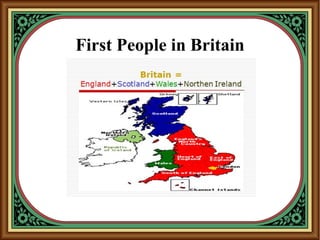The celts
•Télécharger en tant que PPT, PDF•
2 j'aime•2,423 vues
First people in Britain
Signaler
Partager
Signaler
Partager

Recommandé
Contenu connexe
Tendances (20)
Stone Age, Bronze Age, Iron Age, Celtic and Early Christian Ireland

Stone Age, Bronze Age, Iron Age, Celtic and Early Christian Ireland
En vedette
En vedette (20)
Elementos Arquitectónicos de la Arquitectura Europea 1750-1900

Elementos Arquitectónicos de la Arquitectura Europea 1750-1900
15-Dr Ahmed Esawy imaging oral board of sinus ,ear,fascial nerve ,mastiod ima...

15-Dr Ahmed Esawy imaging oral board of sinus ,ear,fascial nerve ,mastiod ima...
RAYCHEM RPG CABLE TIE STOCKIST-AKBAR TRADING EST-Stainless Steel Ball Lock Ca...

RAYCHEM RPG CABLE TIE STOCKIST-AKBAR TRADING EST-Stainless Steel Ball Lock Ca...
The Proto-Burst Buffer: Experience with the flash-based file system on SDSC's...

The Proto-Burst Buffer: Experience with the flash-based file system on SDSC's...
Similaire à The celts
Similaire à The celts (20)
Plus de Pato_Ch
Plus de Pato_Ch (20)
Written near a port on a dark evening charlotte smith

Written near a port on a dark evening charlotte smith
The pains of sleep by samuel taylor coleridge (bianca, juana and sol)

The pains of sleep by samuel taylor coleridge (bianca, juana and sol)
Dernier
80 ĐỀ THI THỬ TUYỂN SINH TIẾNG ANH VÀO 10 SỞ GD – ĐT THÀNH PHỐ HỒ CHÍ MINH NĂ...

80 ĐỀ THI THỬ TUYỂN SINH TIẾNG ANH VÀO 10 SỞ GD – ĐT THÀNH PHỐ HỒ CHÍ MINH NĂ...Nguyen Thanh Tu Collection
TỔNG ÔN TẬP THI VÀO LỚP 10 MÔN TIẾNG ANH NĂM HỌC 2023 - 2024 CÓ ĐÁP ÁN (NGỮ Â...

TỔNG ÔN TẬP THI VÀO LỚP 10 MÔN TIẾNG ANH NĂM HỌC 2023 - 2024 CÓ ĐÁP ÁN (NGỮ Â...Nguyen Thanh Tu Collection
Dernier (20)
80 ĐỀ THI THỬ TUYỂN SINH TIẾNG ANH VÀO 10 SỞ GD – ĐT THÀNH PHỐ HỒ CHÍ MINH NĂ...

80 ĐỀ THI THỬ TUYỂN SINH TIẾNG ANH VÀO 10 SỞ GD – ĐT THÀNH PHỐ HỒ CHÍ MINH NĂ...
Kodo Millet PPT made by Ghanshyam bairwa college of Agriculture kumher bhara...

Kodo Millet PPT made by Ghanshyam bairwa college of Agriculture kumher bhara...
Beyond_Borders_Understanding_Anime_and_Manga_Fandom_A_Comprehensive_Audience_...

Beyond_Borders_Understanding_Anime_and_Manga_Fandom_A_Comprehensive_Audience_...
Basic Civil Engineering first year Notes- Chapter 4 Building.pptx

Basic Civil Engineering first year Notes- Chapter 4 Building.pptx
Plant propagation: Sexual and Asexual propapagation.pptx

Plant propagation: Sexual and Asexual propapagation.pptx
Python Notes for mca i year students osmania university.docx

Python Notes for mca i year students osmania university.docx
ICT Role in 21st Century Education & its Challenges.pptx

ICT Role in 21st Century Education & its Challenges.pptx
TỔNG ÔN TẬP THI VÀO LỚP 10 MÔN TIẾNG ANH NĂM HỌC 2023 - 2024 CÓ ĐÁP ÁN (NGỮ Â...

TỔNG ÔN TẬP THI VÀO LỚP 10 MÔN TIẾNG ANH NĂM HỌC 2023 - 2024 CÓ ĐÁP ÁN (NGỮ Â...
This PowerPoint helps students to consider the concept of infinity.

This PowerPoint helps students to consider the concept of infinity.
The celts
- 1. First People in Britain
- 3. Who lived in Britain before the Romans arrived?
- 4. The name 'Iron Age' comes from the discovery of a new metal called iron.
- 5. How do we know information about the Celts? Archaeologists are always trying to find evidence but sometimes it gets found accidently. Some workmen came across a body. The man had been killed 2000 years ago – they still found food in his stomach! His last meal was bread.
- 7. Unfortunately, evidence such as clothes, pots and shoes are rarely found as they rot in the soil. Things made out of stone and metal don't rot so they tell us information. The Celts didn't read and write. It was the Romans that told us in books how the Celts lived.
- 8. The Celts The Celts lived across most of Europe during the Iron Age. People had lived in Britain for thousands of years before the Romans arrived. The Celts lived in roundhouses with thatched roofs of straw or (plant that grows on the hills of northern Britain). In places where there were plenty of trees the walls were made out of wattle and daub (hazel trees with clay and straw).
- 9. In the North of Britain they used large stones and clay to make the walls. This is a roundhouse being built. There are poles to hold up the thatched roof. The settlements are protected by a stone wall with wood.
- 11. The settlements Families lived together in settlements: children, parents, grandparents, aunts, uncles and cousins. The roundhouses were built in groups. The walls protected them from wolves and wild boar. Sometimes groups of houses were built on the top of hills. These were called hill-forts.
